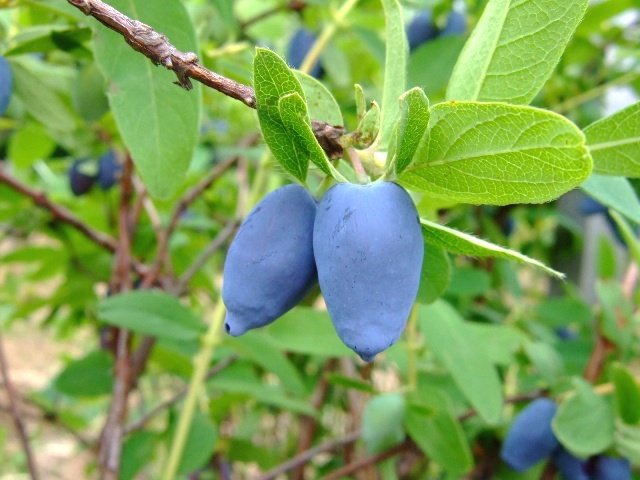The Honeyberry
The history of the honey berry, why Indiana forests are all starting to look the same, and what on earth is Haskap jam.
Lonicera caerulea, April 12th
The most sweat provoking obstacle I’ve endeavored to overcome in recent memory has to be (an attempt) to reclaim a native Indiana forest from a prolifically invasive shrub. The forest in question is that of my in-law’s: a 42 acres stand of oaks, ashes, maples, and tulips planted as saplings in the early 1990’s. By the beginning of 2023, the understory had become one homochromatic smear of Amur honeysuckle, a disturbingly intrusive scourge imported from temperate eastern Asia in the late 19th century.
A small sample: Before
After
Before
After
Formally known as Lonicera maackii (after the German physician and botanist Adam Lonitzer, and Russian explorer and naturalist Richard Maack who collected the specimen in 1855), it is adaptable to a scopic range of conditions from bright sun to deep shade, from wet to dry. It thrives in disturbed habitats including forest edges, forest interiors, floodplains, old fields, pastures, and roadsides. It will grow through piles of cinder rubble and up from the muckiest beds of creeks. Honeysuckle impedes reforestation and prevents reestablishment of native plants. It is so well equipped to survive and flourish in the eastern US, it can (and has) entirely denuded forest floors, as seen in the photos above. Looking out the window along highways and interstates, you can’t help but notice the unyielding repetition of its densely woody branches and ovate Brunswickian leaves. L. maackii has succeeded this efficiently by combining a number of viability strategies. Leaf development and expansion, for example, occurs 2 to 3 weeks earlier than native species, and the final leaf abscission happens much later. The leaves are freeze resistant and hang on into early winter, soaking up additional final rays of life nurturing sunshine before descent into dormancy. The fruits are carbohydrate rich, making them more or less bird candy, which facilitates rapid and widespread dispersal. Paradoxically, they provide considerably less sustained energy for migratory birds than more lipid rich native species, such as dogwood. The characteristic branching pattern provides enticing lofts for nesting birds, but are low to the ground and lead to higher rates of predation. Particularly susceptible, apparently, are robins.
No one plants Lonicera maackii on purpose. At least no one who likes having friends. It is a pernicious, obnoxious blight. It’s very close relative, Lonicera caerulea (pictured here), however, is lovely: decidedly non-invasive, non-vining, and producing delicate lightly scented yellowish-white flowers and an edible, tasty, blueberry-like fruit. It really isn’t planted as much as it should be here in Indiana. They tolerate a wide range of pH’s and are resistant to most diseases and pests, making them relatively carefree. Honeyberry shrubs are long lived, often lasting 50 years or more.
Honeyberry fruit
The epithet caerulea means "dark blue,” a reference to its fruit, which is long and squarish, like the rotting toe of someone with a pituitary disorder, but thin skinned and refreshing. The flavor of the Honeyberry, as it is more commonly called, is hard to describe, landing somewhere between a blackberry and a grape. They are reportedly quite healthful, choc full of anti-oxidants and vitamin C, as well as being great for turning into jam. In Japan, they are called Haskap, derived from its name in the language of the native Ainu people of Hokkaido, and you will often find the jams labelled with this moniker.
Russian stamp
Haskap Jam Recipe
-Curtesy of Ashley Adamant and Practical Self Reliance
INGREDIENTS
2 cups haskap berries (honeyberries), washed and de-stemmed
2 cups sugar
INSTRUCTIONS
Add the haskap berries and sugar to a saucepan, and bring to a boil over medium heat (stirring frequently).
Simmer until the jam reaches gel stage, as tested on a plate in the freezer or with a kitchen thermometer (220 degrees F).
Pack into canning jars, leaving 1/4 inch headspace and seal with 2 part lids.
Store jars in the fridge for immediate use or process in a water bath canner for 10 minutes for a shelf stable honeyberry jam.
Knowledge Sources
https://honeyberryusa.com/about-honeyberry.html
https://en.wikipedia.org/wiki/Lonicera_caerulea
https://en.wikipedia.org/wiki/Lonicera_maackii#cite_note-usfs-5
https://www.fs.usda.gov/Internet/FSE_DOCUMENTS/fsm91_054482.pdf
https://www.invasive.org/alien/pubs/midatlantic/loma.htm
https://pfaf.org/user/Plant.aspx?LatinName=Lonicera+caerulea
https://www.ncbi.nlm.nih.gov/pmc/articles/PMC3736768/
https://www.mda.state.mn.us/plants/pestmanagement/weedcontrol/noxiouslist/amurhoneysuckle
Image Sources
https://commons.wikimedia.org/wiki/File:Lonicera_caerulea_Fruit.JPG
https://commons.wikimedia.org/wiki/File:Russia_stamp_2020_№_2587.jpg







